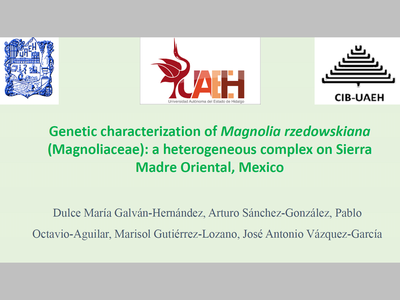Genetic characterization of Magnolia rzedowskiana (Magnoliaceae): a heterogeneous complex on Sierra Madre Oriental, Mexico
DULCE MARÍA GALVÁN-HERNÁNDEZ1, ARTURO SÁNCHEZ-GONZÁLEZ1, PABLO OCTAVIO-AGUILAR1, MARISOL GUTIÉRREZ-LOZANO1 & JOSÉ ANTONIO VÁZQUEZ-GARCÍA2
- Centro de Investigaciones Biológicas, Universidad Autónoma del Estado de Hidalgo, Ciudad del Conocimiento, C.P. 42184, Carretera Pachuca-Tulancingo Km. 4.5, Mineral de la Reforma, Hidalgo, México.
- Centro Universitario de Ciencias Biológicas y Agropecuarias, Departamento de Botánica y Zoología, Herbario IBUG, Universidad de Guadalajara, C. P. 45110, Carretera Guadalajara-Nogales Km. 15.5. Camino Ramón Padilla Sánchez 2100, Nextipac, Zapopan, Jalisco, México.
Magnolia rzedowskiana is a recently described species, with populations of low density, isolated among themselves and restricted to the central region of the Sierra Madre Oriental of Mexico. The constant and frequent loss of individuals of this species, due to different anthropogenic activities, increases their probability of extinction risk. At present, basic aspects of its ecological and evolutionary dynamics are unknown, and studies are required to confirm the taxonomic identity of all the populations considered as part of this species. In the present work, the genetic diversity of M. rzedowskiana, species segregated from the M. dealbata complex, was compared in order to identify the evolutionary processes related to its divergence. Seven populations of M. rzedowskiana distributed in the states of Hidalgo, Querétaro, San Luis Potosí and Veracruz were compared with a population of M. dealbata from the central region of Oaxaca. From the collection of the leaves in the field of at least ten individuals by population, DNA extraction was performed by the CTAB method and PCR amplification was performed using eight microsatellite markers (SSR or simple sequence repeats), selected from previous studies with other Magnolia species, to quantify diversity and genetic structure. The data obtained were analyzed according to the number of alleles per locus (Na), effective number of alleles per locus (Ne), observed (Ho) and expected heterozygosis (He), Shannon index (I) and fixation coefficient (f), to define genetic variation. The genetic structure of the populations was evaluated by means of an analysis of molecular variance, Nei distances (NeiD), Bayesian assignment analysis and multivariate analyses (discriminant functions analysis, principal components analysis). In addition, the excess or deficiency of heterozygotes associated with population reductions was evaluated, as well as the effect of natural selection as a mechanism of differentiation between populations. The results show that the greatest genetic variation occurred in the northern region of the state of Hidalgo (I = 1.09, Ho = 0.65), where inbreeding was absent. Genetic divergence was observed among the studied populations according to the differentiation coefficient (Fst) and number of migrants per generation (Nm), with the exception of the populations of Veracruz and South Hidalgo (Fst = 0.09, Nm = 2.3, NeiD = 0.23). The distribution of genetic groups by Bayesian assignment allowed the identification of a particular group in M. dealbata and three in M. rzedowskiana. However, the analysis of discriminant functions allowed recognizing three groups, one that corresponded to M. dealbata and two to M. rzedowskiana. It was inferred that there are bottlenecks in all of the populations, but they were more evident in the north and south of Hidalgo. It is probable that the genetic differences found among the populations are due to a process of directional selection, unlike M. dealbata where balancing selection was detected, which confirms the independence of both species. The population of San Luis Potosí is related to the two groups identified as M. rzedowskiana. The obtained results suggest a probable process of differentiation between the populations of the north-south of Hidalgo with respect to that of Querétaro; and two hybridization processes, one in the population of San Luis Potosí and another one in the southern Hidalgo-Veracruz populations, but both hypotheses/proposals remain to be tested.

